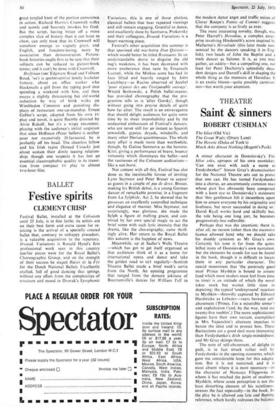BALLET
Festive spirits
CLEMENT CRISP
Festival Ballet, installed at the Coliseum until 25 July, is in fine fettle; its artists are on their best form and extra cause for re- joicing is the arrival of a specially created ballet that, contrary to unhappy precedent, is a valuable acquisition to the repertory. Dvorak Variations is Ronald Hynd's first professional work seen in this country (earlier pieces were for the Royal Ballet's Choreographic Group, and on the strength of their success he staged Raiser de la Fee for the Dutch National Ballet). Excellently crafted, full of good dancing that springs without any effort from the complexities of structure and mood in Dvorak's Symphonic Variations, this is one of those plotless, classical ballets that bear repeated viewings and still remain engaging. Grateful to dance, and excellently done by Samtsova, Prokovsky and their colleagues, Dvorak Variations is a heart-warming piece.
Festival's other acquisition this summer is that spavined old war-horse Don Quixote— which would better be titled Rosinante. In an understandable desire to disguise the old nag's weakness, it has been decorated with more exuberance than taste by Emanuele Luzzati, while the Minkus score has had its face lifted and heavily rouged by John Lanchbery—as Racine observed of Jezebel 'pour reparer des ans l'irreparable outrage'. Witold Borkowski, a Polish ballet-master, has provided choreography that the pro- gramme tells us is 'after Gorsky', though without going into precise details of quite how far after. The result is an extravaganza that should delight audiences for quite some time by its sheer improbability and by the undaunted enthusiasm of Festival's dancers, who are never still for an instant as Spanish townsfolk, gipsies, dryads, windmills, and many other Iberian quaintnessses. The whole zany affair is made more than worthwhile, though, by Galina Samtsova as the heroine, Kitri, giving a performance of brave, bouncy virtuosity which illuminates the ballet—and the vastnesses of the Coliseum auditorium— like a sun-burst.
Not content with all this, Festival has also done us the inestimable favour of inviting Lynn Seymour and Peter Breuer to appear as guests in a couple of pas de deux. Breuer, making his British debut, is a young German dancer of remarkable promise; in a fragment from La Sylphide, Act 2, he showed that he possesses an excellently controlled technique and elegance of manner. Miss Seymour, not surprisingly, was glorious; she made the Sylph a figure of melting grace, and con- trived by her own special magic to act the brief scene with such lyric intensity that the drama, like the choreography, came thrill- ingly alive. Her return to the Royal Ballet this autumn is the happiest of news.
Meanwhile, up at Sadler's Wells Theatre —which has got to get itself organised so that audiences think of it as a home for international opera and dance and take the golden road to Ecl regularly—Scottish Theatre Ballet made a brief week's sortie from the North. An opening programme that ranged from the demure jokiness of Bournonville's dances for William Tell to the modern dance angst and traffic noises of Clover Roope's Points of Contact suggests that the company is as lively as ever.
The most interesting novelty, though, was Peter Darrell's Herodias, a complex enter- prise involving Hindemith's score inspired by Mallarrnes Herodiade (this later made non- sensical by the dancers speaking it in Eng- lish), two heads of John the Baptist and a male dancer as Salome. It is, as you may gather, an oddity—but a compelling one, not least for Peter Docherty's splendidly deca- dent designs and Darrell's skill in shaping the whole thing as the memoirs of Herodias. It is an exotic bloom—quite possibly carnivor- ous—but worth your attention.






























 Previous page
Previous page